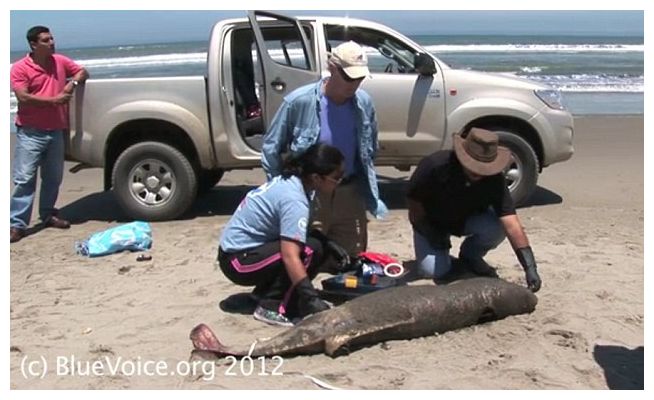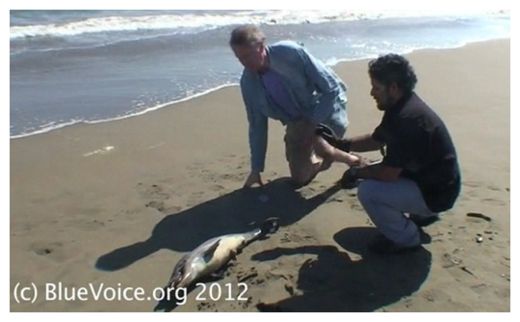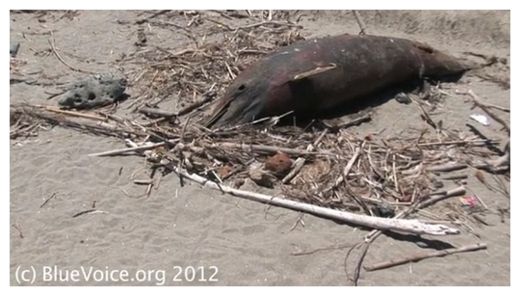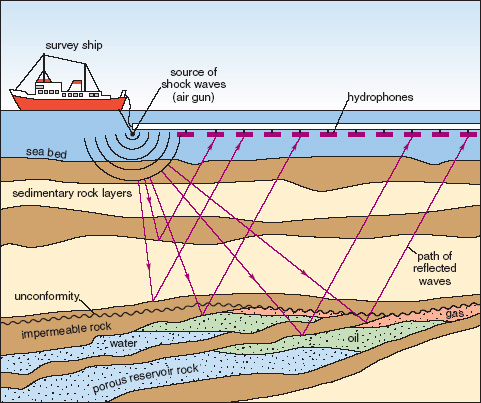PERÚ: petroleo y gas marino SÍ !!! ... delfines NO !!!
How Our Addiction to Oil is Killing Dolphins
.
El efecto de la contaminación acústica submarina es más doloroso que cualquier otra cosa para los animales. La mayoría de los animales se alarman por ruidos extraños. La muerte puede ocurrir debido a hemorragias, cambio del patrón de buceo, migración errática a nuevos lugares, daños a órganos internos y respuesta de pánico a los sonidos extraños. También hay una interrupción en la comunicación normal entre los animales marinos como resultado de la contaminación del ruido subacuático. Los animales afectados por la contaminación acústica, muchas veces no son capaces de llamar a sus compañeros, buscar comida o incluso hacer un pedido de ayuda en tales circunstancias.
Muchos animales marinos, como pescados de peñas, arenques, anguilas san, bacalao, etc) muestran signos de daños a sus sistemas auditivos por exposición a cañones de aire sísmicos incluso a varios kilómetros de distancia. La exposición al ruido durante la etapa embrionaria aumenta la sensibilidad de los peces a los ruidos, aumenta las tasas de mortalidad natal y el desarrollo de anomalías genéticas. La migración a nuevas áreas, no sólo afecta el equilibrio de la diversidad marina, afecta indirectamente a los seres humanos también, por ejemplo disminuyendo la captura de muchas especies de peces como el arenque, el bacalao y la bacaladilla.


La sensibilidad de diversos animales marinos a la contaminación por ruido en los océanos está variando. Mientras que los cetáceos como las ballenas y los delfines pueden mostrar una mayor resistencia, especies como moluscos, gambas, pescado, etc son mucho más sensibles. Sin embargo, es importante tener en cuenta que por lo menos 24 especies de cetáceos han demostrado efectos negativos a la contaminación acústica en el océano. Se ha observado que unas 55 especies marinas han sufrido debido a la exposición al sonido de frecuencias diferentes. Estos incluyen el cachalote, la ballena gris, ballena mink, cachalote pigmeo, la ballena asesina, la lubina, el pargo rosado, peces de colores, el bacalao, el eglefino, el atún rojo, calamares, langosta, camarón café, etc
Hay una razón por la cual al océano se le llama el "mundo del silencio". En este mundo, no hay necesidad de sonidos extranjeros que rompan la armonía. Se están realizando estudios para comprender los efectos de la contaminación acústica en la vida marina de manera mucho más completa.
.
LA NATURALEZA ES LO DE MENOS: MÁS DELFINES MUEREN EN EL NORTE DEL PERÚ
abril 14th, 2012

Patricia Majluf, viceministra de Pesquería, anunció la contratación de expertos internacionales para la realización de un estudio que permita saber si “algún virus marino estaría causando la muerte de los animales” sin embargo el empleo de ultrasonido en la prospección de combustibles fósiles en el mar peruano parece ser el responsable … pór qué el gobierno no aplica el principio de precaución terminando toda prospección petrolera hasta nuevo aviso???

.
Los Sonares de la Marina de EEUU dañan a las ballenas y a los delfines. Echa un vistazo a este vídeo, escucha y ve lo que hace a estos mamíferos marinos. Earthjustice está trabajando para que la Marina emplee sus sistemas de sonar en los lugares donde no dañarán a las ballenas ni a los delfines.
Subido por Earthjustice - Navy sonar harms whales and dolphins. Check out this video and hear what it sounds like, and see what it does to these marine mammals. Earthjustice is working to get the Navy to use their sonar in places where it won't harm whales and dolphins. For more information, go to http://www.earthjustice.org/sonar
.
Adicción al petróleo está matando delfines masivamente
09 de abril 2012 - Los delfines son asesinados por cientos en el Perú, y esta vez el culpable no es el gusto de los japoneses por el sabor de la carne de los delfines ... es nuestra hambre colectiva por el petróleo.
Desde el comienzo del verano en el hemisferio sur, cerca de 3.000 cadáveres de delfines han sido arrastrados hasta la orilla, y la semana pasada 615 fueron encontrados en una sola línea de costa 135 kilometros. Sin signos externos de trauma o evidencia de enfermedad, los expertos opinan que la exploración petrolera en alta mar, en la región, es el culpable más probable.
El biólogo marino Carlos Yaipen cree que una polémica técnica para la detección de petróleo bajo el lecho marino, utilizando un sonar o sensores acústicos, está llevando a la muerte de la vida marina en masa.
"Las compañías petroleras utilizan diferentes frecuencias de ondas acústicas y aunque los efectos producidos por estas burbujas no son claramente visibles, generan efectos mediatos en los animales. Esto puede causar la muerte por impacto acústico, no sólo en los delfines, sino también en los lobos marinos y ballenas. "
En 2003, científicos de la Sociedad Zoológica de Londres descubrieron que el sonar bajo el agua puede conducir a la formación de burbujas microscópicas de nitrógeno en el torrente sanguíneo y en los órganos vitales de los mamíferos acuáticos, lo que afecta a los animales con una condición letal conocida como “the Bends”. Además, los sensores acústicos de bajo rango son sospechosos de causar desorientación por afectar los organos de equilibrio/ audición y hemorragias internas en la fauna expuesta a sus efectos.
En términos más simples, nuestra búsqueda desenfrenada de petróleo está explotando los cerebros de los mamíferos marinos en los océanos de todo el mundo.
Las señales de sonar son tremendamente fuertes, los barcos pueden generar intensidades de sonido sonar tan altas como 215 decibelios y propagarse a unos 160 decibelios a cientos de kilómetros desde la fuente. El tono de llamada telefónica de entre 80 y 140 decibelios puede causar daños auditivos permanentes. Si los humanos tuviéramos la agudeza auditiva de los delfines, la señal del sonar emitidas por las naves de prospección de hidrocarburos serían equivalentes a un tiro en la cabeza.
.
El problema no se limita a la injuria provocada por la señal del sonar, aunque es muy grave, el mayor daño en delfines y mamíferos marinos se produce cuando tratan de huir de la lacerante fuerte de sonido. Al igual que los buzos, si los delfines salen a la superficie demasiado rápido desde aguas profundas, el nitrógeno se acumula en su sangre. El animal emerge demasiado rápido y es incapaz de eliminar de su cuerpo el gas, de manera que este forma burbujas que pueden estallar y destrozar sus órganos vitales, sus tejidos y sus vasos sanguíneos, provocando masivas y letales hemorragias.
.
.
How Our Addiction to Oil is Killing Dolphins
.
Dolphins are being killed in mass quantities in Peru, and this time the culprit isn’t the Japanese taste dolphin meat… it’s our collective hunger for oil.
Since the beginning of the summer, nearly 3000 dolphin carcasses have washed up on shore, and last week 615 were found on a single 135km coastline. With no external signs of trauma or evidence of disease, experts are saying that offshore oil exploration in the region is the most likely culprit.
.
Tree Hugger explains:
Yaipen believes that a controversial technique for detecting oil beneath the seabed, using sonar or acoustic sensing, is leading the death of marine life en masse.
“The oil companies use different frequencies of acoustic waves and the effects produced by these bubbles are not plainly visible, but they generate effects later in the animals. That can cause death by acoustic impact, not only in dolphins, but also in marine seals and whales.”
In 2003, scientists from the Zoological Society of London discovered that underwater sonar can lead to the formation of microscopic bubbles of nitrogen in the bloodstream and vital organs of aquatic mammals, afflicting the animals with a lethal condition commonly known as the Bends. Additionally, low-range acoustic sensors are suspected to cause disorientation and internal bleeding to exposed wildlife.
In simpler terms, our rampant hunt for oil is exploding the brains of orcas in oceans all over the world.
Sonar signals are horrifyingly loud. According to Slate, the ships can register as high as 215 decibels and persist at around 160 dbs hundreds of miles from the source. In case you don’t speak decibels, a telephone dial tone is about 80dbs and 140dbs can cause permanent hearing damage. If you have the the sharply-tuned acoustic system of a whale or dolphin, the sound put out by these ships is practically a bullet to the head.
The problem isn’t so much the signal itself though — it’s what happens when marine animals try to flee from the loud sound. Just like scuba divers, if a dolphin rises to the surface too quickly from deep underwater, nitrogen will accumulate in the blood. If the panicked animal isn’t able to rid its body of the gas quickly enough, the gas forms bubbles that can erupt and rip apart vital organs, tissues, and blood vessels.
Hearing about news like this is tragic and upsetting to say the least, but what bothers me more is the lack of coverage on mainstream media outlets. In fact, what I heard about on when I was watching the news this morning was panic about rising gas prices… not the dire consequences of our oil addiction.
To be honest, I’m glad gas prices are up. I hope they keep going up. We are never going to change our habits if there isn’t some incentive involved… and as it stands now, the price of oil is largely disconnected from the long term consequences of our consuming it. The structure of our political and economic system allows us to ignore the bigger picture — stay oblivious to the fact that every time we fill up our tank we kill another hundred animals, put another coastline community in jeopardy because of global warming.
.

.

Scientists in Peru are exploring the possibility the deaths were caused by sonar blasts used by firms to find oil under the sea. The method can damage dolphins' ears and cause disorientation and internal bleeding, experts warn.
.

.
Nearly 3,000 of the mammals are thought to have died this year so far, with 615 counted by conservationists along a 90-mile stretch of beaches near the city of Lambayeque on Wednesday 13 april 2012.
.
Why Do Whales and Dolphins Strand Themselves on Beaches?
From Larry West, former About.com Guide
Whale Strandings - Why Do Whales and Dolphins Strand ...
environment.about.com/od/.../whale_stranding.h...
.
Question: Why Do Whales and Dolphins Strand Themselves on Beaches?
Few things in nature are more tragic than the sight of a pod of whales—some of the most magnificent and intelligent creatures on Earth—lying helpless and dying on the beach. Mass whale strandings occur in many parts of the world, and we don't know why. Scientists are still searching for the answers that will unlock this mystery.
Answer: There are many theories about why whales and dolphins sometimes swim into shallow water and end up stranding themselves on beaches in various parts of the world.
.
Some scientists have theorized that a single whale or dolphin may strand itself due to illness or injury, swimming in close to shore to take refuge in shallow water and getting trapped by the changing tide. Because whales are highly social creatures that travel in communities called pods, some mass strandings may occur when healthy whales refuse to abandon a sick or injured pod member and follow them into shallow water.
Mass strandings of dolphins are far less common than mass strandings of whales. And among whales, deep-water species such as pilot whales and sperm whales are more likely to strand themselves on land than whale species such as orcas (killer whales) that live closer to shore.
Some observers have offered a similar theory about whales pursuing prey or foraging too close to shore and getting caught by the tide, but this seems unlikely as a general explanation given the number of stranded whales that have turned up with empty stomachs or in areas devoid of their usual prey.
Does Navy Sonar Cause Whale Strandings?
One of the most persistent theories about the cause of whale stranding is that something disrupts the whales’ navigation system, causing them to lose their bearings, stray into shallow water, and end up on the beach.
Scientists and government researchers have linked the low-frequency and mid-frequency sonar used by military ships, such as those operated by the U.S. Navy, to several mass strandings as well as other deaths and serious injuries among whales and dolphins. Military sonar sends out intense underwater sonic waves, essentially a very loud sound, that can retain its power across hundreds of miles.
Evidence of how dangerous sonar might be for marine mammals emerged in 2000, when whales of four different species stranded themselves on beaches in the Bahamas after a U.S. Navy battle group used mid-frequency sonar in the area. The Navy initially denied responsibility, but a government investigation concluded that Navy sonar caused the whale strandings.
Many beached whales in strandings associated with sonar also show evidence of physical trauma, including bleeding in their brains, ears and internal tissues. In addition, many whales stranded in areas where sonar is being used have symptoms that in humans would be considered a severe case of decompression sickness, or “the bends,” a condition that afflicts SCUBA divers who resurface too quickly after a deep dive. The implication is that sonar may be affecting the whales’ dive patterns.
Other possible causes put forth for the disruption of whale and dolphin navigation include:
weather conditions;
diseases (such as viruses, brain lesions, parasites in the ears or sinuses);
underwater seismic activity (sometimes called seaquakes);
magnetic field anomalies; and
unfamiliar underwater topography.
Despite the many theories, and growing evidence of the danger that military sonar poses for whales and dolphins worldwide, scientists have not found an answer that explains all whale and dolphin strandings. Perhaps there is no single answer.
Whale Strandings - Why Do Whales and Dolphins Strand ...
environment.about.com/od/.../whale_stranding.h...
.
.
Related Articles
Whale Watching In Cape Cod - Watching Whales From Shore On Cape Cod
U.S. Navy Allowed to Use Sonar That May Harm Whales - Marine Conservation I...
Learning About Whales Through Photographs - Studying Whales Through Photo-i...
Delphinidae - What Is Delphinidae
.
 http://cdn.marineinsight.com/wp-content/uploads/2011/09/Beached-whales.jpg
http://cdn.marineinsight.com/wp-content/uploads/2011/09/Beached-whales.jpg
 La Corte Suprema de Justicia de EEUU enfrenta demandas por el uso de la Marina de sistemas de sonar de alta intensidad y frecuencia media en la costa sur de California desde 2008. El uso de este tipo de sonar, lo admite la Marina de EEUU, puede perturbar o lesionar de manera significativa a un estimado de 170,000 mamíferos marinos. El empleo de sonar por la marina ha sido impugnado en los tribunales alegando las protecciones que se encuentran en la Ley de Política Nacional del Ambiente de EEUU de 1970. La Marina quiere construir una sistema de sonar que cubra toda la costa este con este tipo de sonar de frecuencia media. También cuenta con varios sitios en mente a lo largo de la costa atlántica, incluyendo el mar frente a Jacksonville debido a su proximidad a la Estación Naval de Mayport y a la Base de Submarinos de la Armada de Kings Bay; sin embargo, estos sistemas están dentro de la ruta de migración de la ballena amenazadas en peligro crítico del Atlántico Norte y tiene el potencial de impactar una variedad de otros mamíferos marinos como delfines mulares y ballenas piloto. Más allá del impacto en los mamíferos marinos, estos sonares pueden afectar el hábitat marino. La ONG Oceana ha trabajado con los Consejos de Gestión de Pesca de Nueva Inglaterra y del Atlántico Sur sobre las propuestas para proteger y designar los cañones de aguas profundas y los ecosistemas de coral de aguas profundas como Hábitat de Preocupación Particular. La Marina de los Estados reconoce que cuatro de estos sistemas de radares se encuentran dentro y / o al lado de Hábitat de aguas profundas de Preocupación Particular . Los corales de aguas profundas que se encuentran en las zonas afectadas incluyen Lophelia y Oculina. Cinco especies de tortugas marinas se encuentran también en cuatro áreas dentro de rangos de sonar propuestos de la costa atlántica. Todas las tortugas marinas que nadan en las aguas de Estados Unidos están en peligro de extinción o amenazadas y enlistadas bajo la Ley de Especies en Peligro de Extinción. Las cinco especies que pueden verse afectados por los campos de sonar son las tortugas carey y laúd, la tortuga verde, tortuga loggerheads ( boba ) y las tortugas marinas kemp’s ridley ( loras ).
La Corte Suprema de Justicia de EEUU enfrenta demandas por el uso de la Marina de sistemas de sonar de alta intensidad y frecuencia media en la costa sur de California desde 2008. El uso de este tipo de sonar, lo admite la Marina de EEUU, puede perturbar o lesionar de manera significativa a un estimado de 170,000 mamíferos marinos. El empleo de sonar por la marina ha sido impugnado en los tribunales alegando las protecciones que se encuentran en la Ley de Política Nacional del Ambiente de EEUU de 1970. La Marina quiere construir una sistema de sonar que cubra toda la costa este con este tipo de sonar de frecuencia media. También cuenta con varios sitios en mente a lo largo de la costa atlántica, incluyendo el mar frente a Jacksonville debido a su proximidad a la Estación Naval de Mayport y a la Base de Submarinos de la Armada de Kings Bay; sin embargo, estos sistemas están dentro de la ruta de migración de la ballena amenazadas en peligro crítico del Atlántico Norte y tiene el potencial de impactar una variedad de otros mamíferos marinos como delfines mulares y ballenas piloto. Más allá del impacto en los mamíferos marinos, estos sonares pueden afectar el hábitat marino. La ONG Oceana ha trabajado con los Consejos de Gestión de Pesca de Nueva Inglaterra y del Atlántico Sur sobre las propuestas para proteger y designar los cañones de aguas profundas y los ecosistemas de coral de aguas profundas como Hábitat de Preocupación Particular. La Marina de los Estados reconoce que cuatro de estos sistemas de radares se encuentran dentro y / o al lado de Hábitat de aguas profundas de Preocupación Particular . Los corales de aguas profundas que se encuentran en las zonas afectadas incluyen Lophelia y Oculina. Cinco especies de tortugas marinas se encuentran también en cuatro áreas dentro de rangos de sonar propuestos de la costa atlántica. Todas las tortugas marinas que nadan en las aguas de Estados Unidos están en peligro de extinción o amenazadas y enlistadas bajo la Ley de Especies en Peligro de Extinción. Las cinco especies que pueden verse afectados por los campos de sonar son las tortugas carey y laúd, la tortuga verde, tortuga loggerheads ( boba ) y las tortugas marinas kemp’s ridley ( loras ).
.

seismic air guns
.

.

.
 Via IFAW.org/Screen capture, Cape Cod Stranding.
Via IFAW.org/Screen capture, Cape Cod Stranding.
.
Naval Sonar Could Affect Whales, Dolphins
Posted Wed, Oct 22, 2008 by J.L. Frank to dolphins, Navy, SONAR, whales
Next spring, the Supreme Court will weigh in on the U.S. Navy’s use of high-intensity, mid-frequency sonar off the southern California coast. Use of this type of sonar, which the Navy admits may significantly disturb or injure an estimated 170,000 marine mammals, was challenged in court based on protections found in the National Environmental Policy Act of 1970. Now that oral arguments before the Supreme Court have concluded, we must wait for its decision in 2009. The Navy wants to build an east coast sonar range using this same mid-frequency sonar. It has several sites in mind along the Atlantic Coast, including off Jacksonville, FL because of its proximity to Mayport Naval Station and to Kings Bay Naval Submarine Base. However, each proposed range is also within the migration path of the critically endangered North Atlantic right whale and has the potential to impact a variety of other marine mammals like bottlenose dolphins and pilot whales. Check out the fact sheet for more info. Beyond the impact to marine mammals, the potential training ranges may also impact important ocean habitat. Oceana has worked with both the New England and South Atlantic Fishery Management Councils on proposals to protect and designate deep-sea canyons and deep sea coral habitats as Habitat Areas of Particular Concern. The Navy states in its review that some of these areas lie within/and or adjacent to all four range locations. Deep sea corals that lie in the affected areas include lophelia and oculina. Five species of sea turtles are also found in all four proposed Undersea Warfare Training Ranges. All sea turtles that swim in US waters are listed as endangered or threatened under the Endangered Species Act because they are on the brink of extinction. The five species that may be impacted by the training ranges are hawksbills, leatherbacks, greens, loggerheads, and kemp’s ridley sea turtles.
.
.
The sonar used by the Navy in conducting training exercises has been found to harm and even kill whales and dolphins (possibly by damaging their eardrums, possibly from physical trauma, possibly by disorienting them). President Bush overrode objections from environmentalists and ordered the sonar back in use, but a federal judge ruled that Bush had no such authority and ordered the sonar use halted again. Both Bush and the Navy proclaim that this is not over.
Oh, "Accelerate your life" is the current Navy recruiting slogan.
http://www.oceansinitiative.org/acoustics/
.
U.S. investigates if Canadian naval exercises are linked to killer whale’s death
Published On Mon Apr 09 2012
 The battered body of a three-year-old female killer whale washed up on Long Beach, Washington. Experts are now trying to determine if sonar testing by a Canadian naval ship may have contributed to the death of the endangered species.
The battered body of a three-year-old female killer whale washed up on Long Beach, Washington. Experts are now trying to determine if sonar testing by a Canadian naval ship may have contributed to the death of the endangered species.




